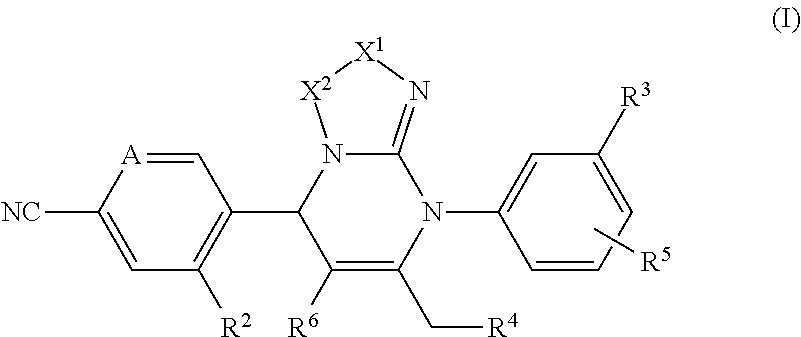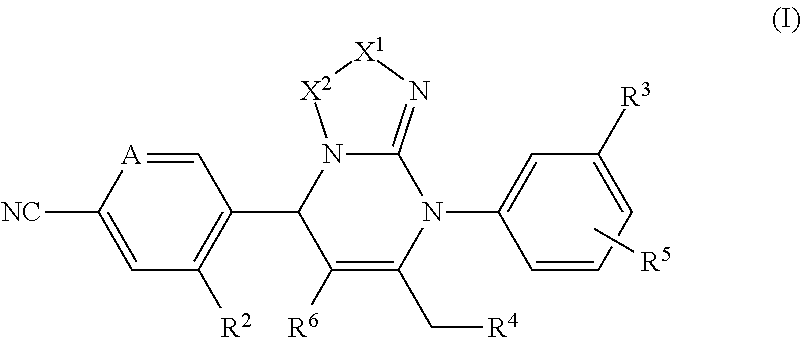Pyrimidine derivatives and their use in the treatment of respiratory diseases such as COPD
a technology of pyrimidine and derivatives, applied in the field of pyrimidine derivatives, can solve the problems of loss of elasticity, excessive hne, and breakdown of pulmonary morphology
- Summary
- Abstract
- Description
- Claims
- Application Information
AI Technical Summary
Benefits of technology
Problems solved by technology
Method used
Image
Examples
example 1
[0140]
7-(4-Cyanophenyl)-2-(2-dimethylaminoethylcarbamoyl)-5-methyl-4-(3-trifluoromethyl-phenyl)-4,7-dihydro[1,2,4]triazolo[1,5-a]pyrimidine-6-carboxylic acid ethyl ester
[0141]A mixture of Intermediate 2 (100 mg, 0.20 mmol), N,N-dimethylethylenediamine (27 mg, 0.30 mmol) and DIPEA (104 mg, 0.80 mmol) in DMF (3 ml) was treated with HATU (92 mg, 0.24 mmol). The reaction was stirred at RT for 4 hours and then the volatiles were evaporated. The residue was partitioned between ethyl acetate and sat. NaHCO3(aq). The organic layer was separated, dried (Na2SO4) and evaporated. The crude product was purified using HPLC system 1 and obtained as a white solid.
[0142]Yield: 61 mg (54%)
[0143]LC-MS (Method 3): Rt=3.78 min, m / z=568.30 [M+H]+
example 2
[0144]
5-(4-Cyanophenyl)-2-(2-dimethylaminoethyl)-7-methyl-3-oxo-8-(3-trifluoromethylphenyl)-2,3,5,8-tetrahydro[1,2,4]triazolo[4,3-a]pyrimidine-6-carboxylic acid methyl ester
[0145]Intermediate 4 (655 mg, 1.71 mmol), 3-(trifluoromethyl)phenylboronic acid (652 mg, 3.43 mmol) and copper (II) acetate (421 mg, 3.43 mmol) were dissolved in pyridine (25 ml). The reaction was heated at 55° C. open to air for 6 hours and then allowed to stand at RT for 17 hours. The solvents were evaporated and the residue was dissolved in methanol. The solution was loaded onto an Isolute® SCX-2 cartridge (20 g) which had been conditioned with methanol. The cartridge was flushed with methanol and then the product was eluted with 2M ammonia in methanol. The crude product was chromatographed on an Isolute® SPE Si II cartridge (10 g) eluting with 1:1 ethyl acetate / pentane. 40 mg of this semi-purified material was further purified using HPLC system 2. The product was obtained as a white solid.
[0146]Yield: 40 mg (...
example 3
[0148]
7-(4-Cyanophenyl)-2-(3-dimethylaminopropyl)-5-methyl-4-(3-trifluoromethylphenyl)-4,7-dihydro-[1,2,4]triazolo[1,5-a]pyrimidine-6-carboxylic acid ethyl ester
[0149]Intermediate 7 (200 mg, 0.51 mmol), 3-(trifluoromethyl)phenylboronic acid (193 mg, 1.02 mmol), copper (II) acetate (125 mg, 1.02 mmol) and triethylamine (206 mg, 2.04 mmol) were stirred under air at RT for 3 days. The volatiles were evaporated and the residue was dissolved in pyridine (3 ml). The reaction was allowed to stand in air at RT for 3 days and then heated at 50° C. overnight. The pyridine was evaporated and the residue was partitioned between DCM and 1M NaOH(aq). The organic layer was separated, washed with water, dried (Na2SO4) and evaporated to give a brown residue. The product was isolated using HPLC system 1. Example 3 was obtained as a white solid.
[0150]Yield: 9 mg (3%)
[0151]LC-MS (Method 3): Rt=3.82 min, m / z=539.26 [M+H]+
PUM
| Property | Measurement | Unit |
|---|---|---|
| Fraction | aaaaa | aaaaa |
| Fraction | aaaaa | aaaaa |
| Flow rate | aaaaa | aaaaa |
Abstract
Description
Claims
Application Information
 Login to View More
Login to View More - R&D
- Intellectual Property
- Life Sciences
- Materials
- Tech Scout
- Unparalleled Data Quality
- Higher Quality Content
- 60% Fewer Hallucinations
Browse by: Latest US Patents, China's latest patents, Technical Efficacy Thesaurus, Application Domain, Technology Topic, Popular Technical Reports.
© 2025 PatSnap. All rights reserved.Legal|Privacy policy|Modern Slavery Act Transparency Statement|Sitemap|About US| Contact US: help@patsnap.com



